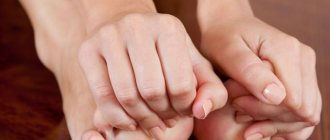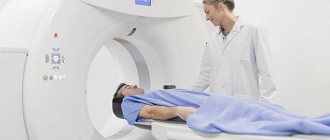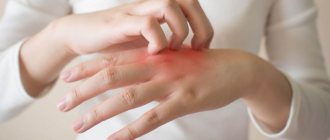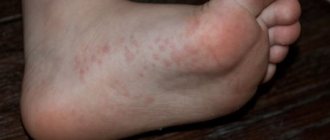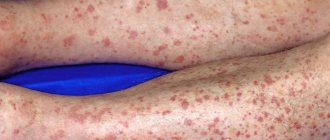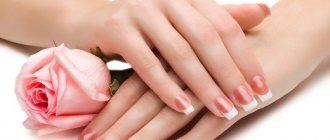The formation of water pimples on the body and legs is a fairly common problem that a person faces at almost any age. This kind of rash initially causes not only physical discomfort, but also moral and psychological discomfort, such as the legs. Especially in the summer and especially for women, they should be open, but here it’s such a misfortune.
Against this background, it is very easy for not only stress to form, but also depression, which leads to a deterioration in a person’s general well-being. This affects poor health and productivity, that is, it affects all areas of life.
Watery pimples are always unstable; they either appear on the skin or suddenly disappear. However, this does not in any way relieve a person from the desire to get rid of acne once and for all.
Interestingly, watery pimples on the legs can often appear in winter, when a person is wrapped up in things. However, this is not an indicator for this type of rash, and water pimples feel great in the summer. in this regard, information about how acne forms will be extremely useful?
Please note that ignoring the problem will not lead to its resolution. The fact is that most people, when such pimples appear on their legs, and even in winter, simply prefer not to pay attention to them, because the rash is hidden under clothes. Logical, but also dangerous, since a rash always indicates processes in the body that cannot be ignored.
Why are pimples on fingers dangerous?
If you do not take care of your feet and do not eliminate the causes of blisters, this can lead to the following complications:
- Weeping ulcer. The appearance provokes the opening of a blister and infection in the wound.
- Erysipelas. It occurs due to the entry of streptococcus bacteria through cracks. It is dangerous to develop lymphostasis, in which the outflow of lymph from the lower extremities is disrupted.
- Gangrene. In advanced cases, cell death in the leg occurs, which can result in amputation or death.
Eczema
The causes of this disease have not been clarified to this day, so it is not yet possible to cure it completely. It can be provoked by: dysbacteriosis, deficiency or excess of vitamins, malfunctions of the digestive organs, kidneys, weakened immunity and other factors. Eczema spreads, most often, on the extremities, manifesting itself first as itchy redness, and then as blisters on the affected areas. The disease has several stages and types, and each subsequent one is controlled worse and worse. Therefore, timely medical intervention is necessary. The disease most often occurs in a dry form, but sometimes a weeping form occurs, causing even greater discomfort on the feet due to watery rashes.
Prevention
After wearing a cast for a long time during a fracture, to prevent acne and cracks, you should pay attention to the care of the skin between the fingers, since the lack of air under the retainer contributes to the appearance of diaper rash and the activation of microbes.
To avoid pimples between your toes, you should choose the right shoes - from natural materials, strictly according to size and season. It is prohibited to use other people's slippers, socks, or tights. After visiting the beach and bathhouses, it is recommended to take a shower and treat your feet with an antifungal spray. You should also avoid shaking hands and hugging people you don’t know well.
Various types of acne are a very common problem among many people of different ages. Water pimples on the legs and body can appear in both men and women, causing considerable discomfort. There are many reasons for their appearance, but in any case, these neoplasms require certain treatment. How to get rid of pimples on legs?
Some types of lichen
Psoriasis is also a representative of lichen, but there are other types of this disease that are completely different from it. These include:
- Shingles. It is characterized by an increase in temperature with significant lesions, rashes in the form of many watery blisters with cloudy contents, pain and itching in the initial stages;
- Pityriasis rosea. During this disease, spots appear on the skin and rashes in the form of blisters with a red border. Sometimes they are accompanied by slight pain, but they never merge with each other, which is typical only for this type of lichen;
- Lichen planus is a non-contagious disease. Rashes in the form of bright papules are very characteristic and do not cause difficulties for the doctor in diagnosis. After recovery, red spots remain at the site of the rash for a long time.
Each type of lichen has its own treatment, therefore, even if you suspect you have one or another type of disease, consultation with a doctor to prescribe the correct therapy is mandatory.
It is important to understand that lichen itself, and other dermatological reactions with which it can be confused, can be signals of other, more serious diseases, including various types of cancer
Treatment
If you have itchy, watery blisters on your hands, seek help. The more severe the rash, the more often they are accompanied by a deterioration in general condition and an increase in temperature. If the blisters grow, turn red and hurt (possibly even fester), and the area around them swells, it is better to call an ambulance, as there is a high probability of infection.
In any case, only a doctor will determine the exact cause of the disease and tell you how to treat the blisters on your fingers. Don't panic: in the vast majority of cases, rashes go away as soon as the cause of their occurrence is eliminated. This may happen in a few days or weeks.
Treatment of the disease is chosen after diagnosis. If the cause of the itchy rash is scabies, it will be treated with external medications within a week. The therapy uses sulfur ointment for watery blisters on the hands and other medications.
If the rash in children or adults is caused by chickenpox, the patient may be hospitalized. For mild forms, treatment is possible at home. Patients are recommended antiviral and antipyretic drugs and local remedies that dry out pimples.
Fungal blisters are treated with topical creams and ointments. They are used to treat the affected areas. Often such drugs are toxic, so only a doctor should select them.
If watery blisters on the hands become an allergic reaction, treatment will be carried out using antihistamines: internal and external.
In any case, you should not diagnose yourself. This can only harm you. Let your doctor determine the cause of the problem and tell you what to do.
Reasons for appearance
Any kind of pimples, comedones, acne and dropsy on the skin bring not only discomfort and pain, but also make it less attractive to others. Watery pimples on the body and legs may indicate certain pathological processes that have arisen in the body, or a decrease in immune defense.
There are many factors that can cause watery acne. But the main one is sensitive skin. In general, the reasons why water pimples appear on the legs can be divided into two categories - external and internal.
The most common root cause of their appearance in women is shaving. Often the fair sex faces the problem of irritation after shaving in the form of flaking, severe itching, burning and small rashes. Therefore, dermatologists advise adhering to certain rules of depilation or even changing the chosen shaving method.
READ ALSO: Herpes on the pubis in women and men: causes, symptoms, treatment methods
The greatest irritation is caused by depilation using wax and depilator. However, even banal shaving with a machine can provoke such a consequence. This may be due to an old, dull razor, dry shaving, or not using emollients after shaving.
Internal causes of water acne include:
- colds;
- decreased immune defense;
- exacerbation of chronic diseases;
- lack of certain vitamins and microelements;
- allergic reaction;
- disturbances in the functioning of the digestive system, which often leads to acne.
Very often, dropsy appears precisely in the cold season, since it is at this time that viral diseases and colds become significantly worse and immunity is significantly reduced. Also, pimples on the feet and hips can become a symptom of an allergy to the fabric of clothing, to the skincare products used, as well as to other external irritants.
Possible external causes of acne on the legs:
- irritation after shaving
- incorrectly selected skincare products;
- severe dry skin and neglect of moisturizing cosmetics;
- poor hygiene or lack thereof;
- irritation on the fabric of clothing or as a result of exposure to sunlight in the summer.
Dermatological diseases cannot be left aside. Of these, the most common are:
- demodicosis, which causes itching, blisters, inflammation in the body;
- shingles, which is characterized by the appearance of watery pimples all over the body;
- herpes - most often the hands, face, lips are affected;
- fungus.
In recent decades, cases of rashes as a result of unstable functioning of the nervous system have become more frequent. Therefore, dermatologists often notice all kinds of rashes after severe stress, depression, nervous shock, and so on.
In any case, if you notice this kind of rash on your body, you should consult a dermatologist. Because if pimples appear on your hands, fingers, body or legs that cause discomfort, this may be an alarming sign. But the root cause of their appearance can be much more serious and more dangerous to human health and even life. Moreover, there are many reasons for the appearance of dropsy.
Causes of dropsy on the feet
Experts often note incorrectly selected shoes as a separate cause of dropsy. Usually those who prefer shoes with heels complain about this problem. It is also possible that acne can form on the feet due to the wrong choice of shoes - the wrong size, synthetic inner filler, uncomfortable shoe shape, and so on.
Therefore, doctors advise choosing first of all comfortable shoes, preferably made from natural fabrics. It is worth paying attention to socks. It is better to buy cotton socks, but you need to change them every day for clean ones so as not to provoke the appearance of fungus, which can also manifest itself in the form of small watery pimples on the toes and on the sides of the feet.
Another common cause of watery feet is hyperhidrosis. This is a very popular problem today for both men and women. Therefore, it is necessary to use various means to reduce the amount of sweat produced:
- deodorants and talc for feet;
- remedies for hyperhidrosis - Teimur paste, Dry Dry, etc.
Dermatologists recommend washing your feet with tar soap, as it does an excellent job of removing excess oil.
Dropsy between legs
Pimples between the legs, on the inner thighs, bring a lot of discomfort. In addition, it is not so easy to get rid of them, since the dermis in this place is particularly sensitive, thin and often subject to friction.
All over the body
If there are blisters on the child’s body, i.e. throughout the body, that is, there is a very high probability that the cause is one of the infections. Moreover, many of these diseases are contagious, so it is better to call a doctor at home. Possible causes of rashes:
- streptoderma;
- chicken pox;
- follicular tonsillitis;
- erysipelas;
- enterovirus;
- shingles;
- pemphigus;
- herpes types 1 and 2.
In case of infection, in addition to rashes, fever, general weakness and chills are observed. The location of the bubbles may indicate the type of disease. For example, with pemphigus, a rash appears on the abdomen, around the navel and on the thighs. A variation of this disease is Ritter's disease (exfoliating dermatitis). The blisters first appear around the mouth, usually during feeding (if the woman has cracked nipples), and then spread throughout the body. Erysipelas also begins in the area around the navel, after which it quickly spreads to neighboring tissues.
Why do pimples appear?
The main factors that cause acne between the toes are:
- Scabies mite. Infection with scabies occurs as a result of bodily contact with a sick person or his clothing that has not been sanitized. Red, watery blisters appear on the toes and hands. In advanced cases, the infection spreads to other parts of the body. Pimples itch very much at night, when the mite is active.
- Allergic reaction. It is found on the legs of children and adults. Occurs as a result of an immune response to an allergen - preservatives in food, clothing made from unnatural materials, medications, foot cosmetics. A red or watery blister forms on the affected skin, accompanied by severe itching.
- Hyperhidrosis. If small pimples filled with clear fluid appear between your toes, this may be skin irritation due to excessive sweating. The condition is provoked by tight socks in the hot season and shoes with poor ventilation. Hyperhidrosis also occurs due to a hormonal disorder, vegetoneurosis.
- Uncomfortable shoes. Narrow and tight shoes cause compression of the toes, resulting in chafing - a small transparent blister that hurts a lot. Redness may form around the pimple.
- Psoriasis. It is characterized by the appearance of large raised pimples, severe itching and peeling. Most often it is formed due to stress or emotional shock.
- Fungi. Small white pimples appear. Accompanied by a floury type of peeling, the formation of cracks and wounds between the fingers, roughening of the skin, and brittle nails. You can catch the fungus in bathhouses, on the beach, or in a hostel. especially when using other people's personal hygiene items.
READ ALSO: Roseola (sudden exanthema)
On the face
Blisters on a child’s face occur for the following reasons:
- herpes. The rash is localized on the lips or around the mouth. In the first 2-3 days it causes itching, after which it opens and becomes covered with crusts;
- viral infections: scarlet fever, influenza, rubella, chicken pox, measles;
- allergic reaction to sunlight. Blisters are localized under the eyes and on the chin.
Almost all infections do not have a rash localized only on the face. Most often, rashes are observed on other parts of the body. Only herpes is characterized by a rash of a certain localization, most often around the mouth.
Video “Small blisters on the body and legs”
Video broadcast with information about small bubbles on the body: what they are and how to deal with such a problem.
Diagnosis and treatment First of all, you need to consult a dermatologist. For a more thorough examination, the doctor may take several tests, among which scraping from the surface of the skin is mandatory. Thanks to it, you can detect possible bacteria and fungi on it. Next, the condition of the dermis and the rashes themselves are studied using special equipment. This will help to draw a conclusion about the current condition of the affected skin area.
In the future, the dermatologist prescribes therapy and, possibly, not only medication. The treatment chosen will depend on the underlying cause of the disease. If the disease is not completely cured, but only its symptoms are eliminated, then it can develop further, and the affected area will increase, as will the degree of the disease.
Watery pimples on the feet, hands and body should not be squeezed out, as this can cause infection and leave scars.
Drug therapy
Medicines for both internal and external use are prescribed only by a doctor and self-medication can negatively affect the condition of your skin. In case of allergic reactions, antihistamines are usually prescribed, for example Suprastin, Loratadine, Cetrin, etc.
If infections occur in the body, it is necessary to take antifungal drugs and antiviral drugs. Often infections in the body appear due to decreased immunity, so immunomodulators are prescribed, for example, Viferon suppositories. For nervous disorders, sedatives are recommended.
Along with internal treatment, local medications are prescribed. Usually these are antifungal, anti-inflammatory ointments, which are selected depending on the situation and diagnosis. You can also use more loyal, traditional therapy, but only on the advice of a doctor.
Traditional methods
If pimples and dropsy appear on your feet and itch, you can use some folk recipes. The most effective remedy for acne and skin irritations is aloe juice. This is a plant rich in vitamins and microelements that can be used for various dermatological problems.
To do this, juice is squeezed out of an aloe leaf and applied to the affected area. Aloe leaves can also be used as a lotion. But you need to remember that it is better not to apply aloe to healthy skin, as it can cause irritation and burns.
Calendula tincture is also a time-tested remedy. To treat the skin effectively use herbal decoctions:
If there is no result or the situation worsens, you should consult a doctor.
Watery blisters on the skin of the hands: What is it?
Watery blisters on the hands are small formations protruding above the skin level, the diameter of which does not exceed half a centimeter. They differ from healthy skin in color and in most cases are red or pinkish in color. Inside, such rashes are filled with clear (serous) or bloody fluid.
When rubbed or pressed, the bubbles can burst, leaving a wound in their place. This most often occurs with blisters on the palms of the hands when a person wipes their hands, grasps a door handle, or performs other daily activities.
Typically, the appearance of watery blisters on the fingers or toes is preceded by redness of the skin, possibly peeling and increased sensitivity. Also, the rash is sometimes accompanied by swelling, burning and itching.
Before you begin treatment for the disease, you need to accurately determine the cause of the rash. As a rule, when the cause is eliminated, the rash goes away quite quickly: usually within a few days, sometimes longer. Let us list the main reasons that cause such a reaction.
Allergy
Watery blisters between the fingers, palms and hands can be a manifestation of an allergy to cosmetics, the sun or chemicals. In this case, itchy pimples appear exactly in the place that came into contact with the allergen. Most often these are fingers or palms, but sometimes also wrists (the reaction can occur, for example, to a watch strap).
The blisters may be painful, itchy, and crusty. This is quite dangerous: damage to the crust can lead to purulent infection. Without treatment, the rash can grow, coalesce, and affect more and more of the skin.
Infectious diseases
Watery blisters on the hands can be a symptom of an infectious disease. If the red rashes are very itchy and spread from the palms of the hands to the stomach and legs, there is a possibility that the patient has scabies. Such blisters can appear after a scabies mite bite or as a result of contact with a sick person in a public place. Scabies is a very painful and contagious disease, so it needs to be treated urgently.
Often, a rash on the hands can be a consequence of other infectious diseases: chickenpox, rubella, measles, enterovirus infection, etc. These diseases are thought to affect children more often, but in fact, teenagers and adults can also become infected. Depending on the type of disease, the rash may vary in shape and size. These can be small subcutaneous pimples or larger ones with pus.
If, in addition to rashes, a person feels unwell, has a fever and a headache, the likelihood of an infectious disease increases. Call a doctor immediately!
Internal diseases
Disorders of the gastrointestinal tract (gastritis, ulcers and other diseases) also affect the condition of the skin. Exacerbation of such diseases can lead to skin rashes in the form of small, fluid-filled blisters. This indicates the accumulation of toxins in the body or metabolic disorders.
Treatment of blisters on the hands in these cases should be comprehensive. First of all, you need to cleanse the body of toxins and restore the functioning of the gastrointestinal tract. Local treatment for this reason will not work.
Skin diseases
Rashes with clear liquid may also indicate fungal diseases. Along with the rash, the skin may become dry, red, and flaky. Another symptom of fungus is severe itching. At the slightest suspicion of a fungus, you should immediately contact a dermatologist, as the disease can infect your loved ones.
External reasons
Blisters on the skin may be a reaction to thermal burns from hot water, steam, iron or other devices. Burned skin usually feels hot and sore and red. After some time, a bubble forms at the burn site.
How to treat allergies
When experiencing skin rashes, many people look at their hands with horror, begin to panic and wonder what to do. There is no need to panic. First of all, to avoid complications, you need to start washing your hands with bactericidal, preferably liquid soap.
Household chemicals often lead to similar phenomena. The skin of the hands is sensitive and cannot withstand the onslaught of chemicals, as well as frequent contact with water. It is better to wear gloves when washing and using powders.
For itching and burning, you can use skin-soothing mash, baths with the addition of chamomile, or string. Baths with peat oxidate and a water temperature of 37°C help well. You need to repeat the procedure for several days. If a scabies mite has penetrated the skin, you cannot avoid treating the skin with Spregal, Benzyl benzoate. In this case, it is necessary to disinfect all things, treat them thermally or even chemically.
READ ALSO: Eye damage from herpes zoster virus | Competently about health on iLive
Allergies should not be confused with scabies. These are completely different diseases that differ in symptoms and treatment. It is best to seek help from a doctor immediately.
Treatment recommendations
Acne on the feet is often confused with dry calluses, so self-medication is ineffective. To get rid of profuse rashes on the body and legs as soon as possible, it is recommended to adhere to the following rules:
- choose clothes and shoes only from natural fabrics;
- give up heels at least for a while;
- change skincare products;
- if possible, take air baths as often as possible.
It is also recommended to replenish the vitamin balance in the body. To do this, you need to take vitamin A and vitamin E. Prevention is no less important for eliminating dropsy.
The first thing you need to do is cleanse your body by reviewing your daily menu. Instead of junk food, you need to include in your diet foods rich in minerals and vitamins. It is better to completely exclude fried, spicy and highly salty foods from the diet, as they negatively affect the condition of the skin and the functioning of the digestive system.
Regarding sweets, dermatologists say that they take away beauty. Many studies have proven that people who often eat chocolate and sweets often suffer from acne, acne, clogged pores and other skin diseases.
It is imperative to add fermented milk products to your daily diet. It improves the functioning of the gastrointestinal tract, helps cleanse the body, eliminates toxins and speeds up metabolism. As a result, the skin looks more rested and the number of breakouts is significantly reduced.
To prevent the appearance of acne on the feet, as well as corns, it is recommended to regularly cleanse the skin with scrubs, peels, and pedicures. At home, you can use pumice, a heel file, or steaming for this.
Human skin is very susceptible to external and internal irritants. Therefore, if you notice any inflammation, pimples or redness, you need to listen to your body. Perhaps this is just a symptom of a serious disorder or pathology that can be dangerous to human health and life.
Local treatment
So, after the diagnosis has been made and the cause of the rash has been identified, local treatment can be used.
Here you can use old and proven recipes, which include the use of aloe juice. Aloe is generally a plant without which no skin rash on the body can be treated.
For this purpose, the plant used is not young; its juice must contain all the components necessary for treatment. The plant leaf is washed under running water, wrapped in food foil and left in the refrigerator for a day. After which the plant is squeezed out.
The resulting juice does not have to be used in its pure form; it can be diluted in boiled water. Then simply begin wiping the problem areas. Rubbing is done at least once a day, and after about a week you can already see a positive effect.
Another product that can be bought at any pharmacy is calendula tincture for acne - reviews of the product, by the way, are extremely positive. It has a strong anti-inflammatory and antimicrobial effect. Use calendula to wipe the areas where acne forms. It is necessary to wipe no more than 2 times a day, since the tincture is alcohol-based, and any alcohol-containing infusions can dry out the skin.
Let us emphasize once again that these local remedies are only an additional treatment that copes well with the rash, but does not eliminate the very cause of its appearance.
Possible complications
You should not ignore the problem or self-medicate; even ordinary acne can cause serious consequences. Acne that appears on the heels can trigger the onset of such a serious disease as heel fasciitis. With rashes on the extremities, there is a risk of infection, which can lead to gangrene, and in advanced cases, amputation. Terrible complications can be avoided if you seek medical help in a timely manner and follow preventive measures:
- monitor hand and foot hygiene, use antibacterial soap after visiting public places;
- carefully care for the skin of your feet using moisturizers;
- do not walk barefoot in the sauna or swimming pool;
- lead a healthy lifestyle, give up bad habits;
- eat a nutritious, varied diet, including vitamins and minerals in the diet;
- avoid stress and overexertion.
Skin defects cause aesthetic discomfort and unbearable pain, which changes the usual way of life. You should be attentive to any changes in the body in order to quickly get rid of a delicate problem. Timely medical care and medications will help restore health and beauty to the skin without relapses or negative consequences.
On the buttocks and scrotum
Blisters on a baby's bottom are a common symptom of skin irritation. In infants it results from:
- allergies to diaper or underwear materials;
- insufficient hygiene of the genital area;
- rubbing the skin with tight underwear;
- prickly heat (sleeping in a hot room, dressing inappropriately for the weather, hot time of year).
Diaper rash sometimes appears even with sufficient care, if the child has increased skin vulnerability or a tendency to allergic conditions. Miliaria is tiny swellings of the upper layer of skin like reddish or bright pink bubbles. They appear in the back, chest, armpits and neck folds.
A fungal infection can also cause a rash on the buttocks. It forms on the scrotum due to genital herpes. Once it enters the body, this virus remains in it forever and when the immune system weakens, it makes itself felt.
In teenagers, a rash on the buttocks can accompany a disease such as psoriasis. In this case, rashes also occur on other parts of the body: elbows, along the hairline on the forehead, on the head, etc.
